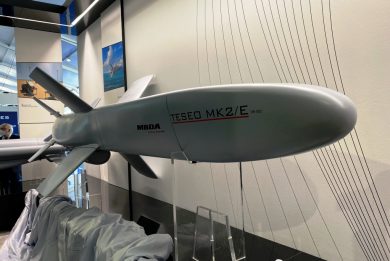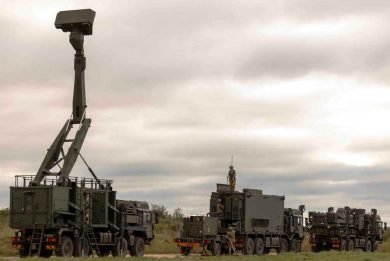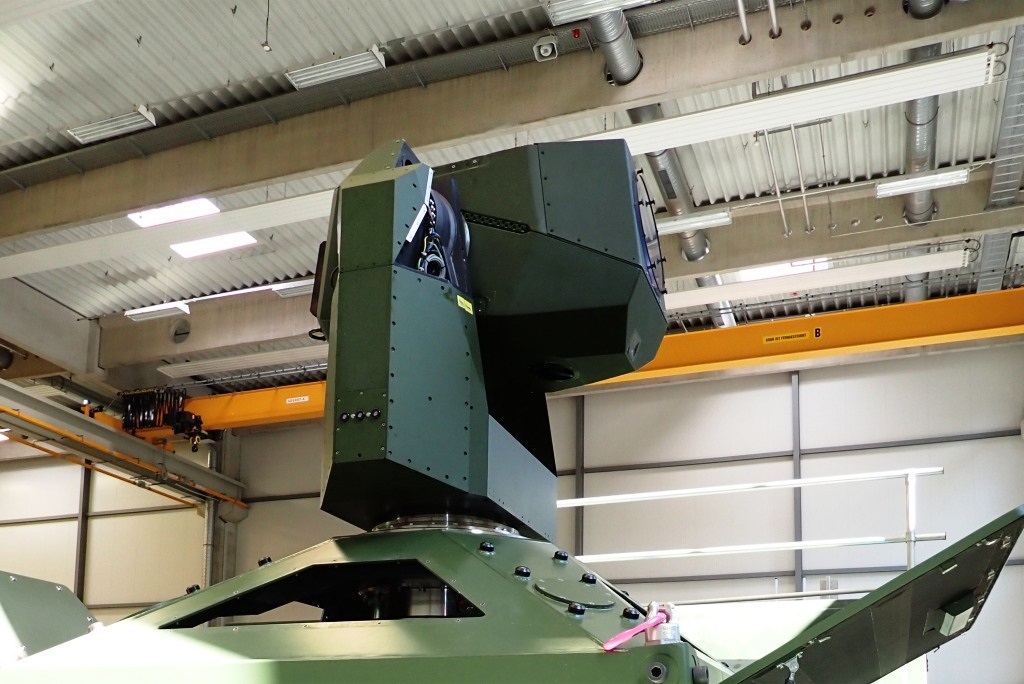
MBDA Deutschland unveils latest laser effector developments
MBDA Deutschland is close to finish the development of two new laser weapon demonstrators (LWDs). The more capable for both naval and ground-based applications identified as LWD 2024 is expected to be ready in the same year alongside the land-based so-called MILOS-D dismounted laser effector capable to be carried by few soldiers or installed on unmanned or manned ground vehicles
Based on a long development roadmap which began in 2008 with proof of concept by demonstrations and first system studies, followed by the development of critical technologies in 2010 and validation of technologies and system concepts/system demonstrator in 2016, MBDA Deutschland has developed and tested in operational environments both naval and land demonstrators in 2022. These activities opened the way to further size reduction, components miniaturization and new technological developments applied to new LWDs which could form the basis for future capabilities. “If you ask when we expect to have laser-based operational weapon systems, my current answer is from 2027 onward,” Doris Laarman, Head of Laser Activities at MBDA Germany stated, presenting the latest developments in this sector.
The company’s funded LWD 2024 represents the follow-on of the High-Energy Laser Naval Demonstrator developed by MBDA Deutschland and Rheinmetall, and recently tested aboard the German Navy Sachsen frigate, under the auspices of the Federal Office of Bundeswehr Equipment, Information Technology and In-Service Support (BAAINBw). Based on the lessons learned from these development and trials activities, and preparing itself for a follow-on development contract phase to design, built and provide an operational laser effector, MBDA is developing on company’s funding a modular, reduced footprint and more capable and integrated LWD, which was unveiled in real during a visit to the Schrobenhausen site.
Although the Bundeswehr hasn’t yet selected a solution, “MBDA has been working on an integrated system module that can be installed on board in place of a RAM launcher or a medium calibre air defence gun,” Doris Laarmann explained. The LWD 2024 demonstrator consists of a newly designed turret based on a coaxial concept and a pedestal, accommodating all the electronics and equipment, except for the power generation and energy storage which is provided by the ship’s propulsion and power generation system. The LWD 2024 volume is expected to be less than a quarter of the 20-foot standard container hosting the recently tested laser effector. The whole system has a mass of 6.5 tonnes, an MBDA representative acknowledged during the visit. Although the power generation comes from the ship propulsion, the LWD could also be operated with batteries for both naval and ground applications.
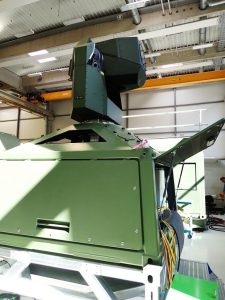
The LWD 2024 turret differs significantly from the previous one as MBDA developed a coaxial system in which the coarse tracking sensor suite, which includes visual and thermal channels as well as the laser range finder, is installed on top of the HEL/fine tracking aperture. Both lasers of the HEL and tracking suites use the same aperture and exactly the same path, thus overlapping is ensured over all distances. The divergence angle of the illumination laser can be significantly decreased by a more efficient use of the laser energy, ensuring a higher tracking range. “Additionally, the illuminator pulse energy has been increased from approximately 20 mJ to 50 mJ to push performance limits up to 5 km,” an MBDA representative explained, while the fine tracking sensor suite also includes passive sensors for gate viewing processing, this solution being under evaluation. MBDA also developed an adaptive optics to allow the system to compensate weather conditions, minimising range reduction in critical situations, that system not being yet installed on the prototype seen at Schrobenhausen. Another key enhancement is the addition of a dedicated surveillance radar with four fixed faces arrays on the pedestal, allowing the search-to-shoot cycle to be conducted fully autonomously from the combat system’s sensor suite, the LWD 2024 command and control console requiring fire control functionalities. This will ensure improved situational awareness and reduced response time against drone swarm attacks. MBDA has already selected the radar to satisfy both performance and cost-effective requirements. Although no details were provided on the HEL output power, EDR On-Line understood the initial iteration of the LWD 2024 suite currently works with a 3 kW laser source to cope with small drone targets up to 3 km, initial testing aiming to validate the new tracking suite in terms of performances and stability. However the yet to-be-released customer requirements could ask for up to 200 kW, depending on the target type, as a more powerful source is required to cope with more demanding threats such as at-sea targets and anti-ship weapon systems. “The concept of the MBDA LWD 2024 can however integrate different sources and make use of any commercially or military available source in Europe,” the MBDA representative added. As for the firing rate, a “shot” against a UAV lasts typically 2-3 seconds, one shot every 10 seconds being the average rate of fire.
According to MBDA, the new LWD2024 is expected to be ready by late 2023 to conduct preparation trials and made fine-tuning activities, which should last a couple of months, before presenting the system to the German MoD around mid-next year.
MBDA Deutschland recently completed trials of its dismounted laser effector demonstrator at the German Army’s Meppen test range, and is working to further develop the system, miniaturizing components and reducing mass to fulfil the customer’s land applications requirements.
The German Army requested a range of laser effectors “to which MBDA responded with the MILOS (Modular Integrated Laser Optical System) family of systems including a portable model (1.5 kW) to be carried by a single soldier, a MILOS-D dismounted version (5 kW) to be transported by two-three soldiers and capable to be used also on UGVs, a remote/integrated model (20 kW) operating on board a vehicle or connected to the same vehicle from a deployed position, and a more powerful and integrated version (60 kW) to be integrated on vehicles,” the company representative said.
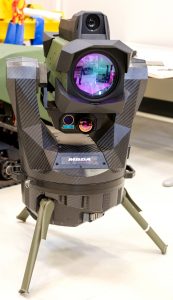
“We approached first the dismounted model to satisfy the requirement to engage static targets, such as materiel, sensors, barbed wires and fences, alongside the portable version,” Doris Laarman told EDR On-Line, the latter being a downgraded iteration of the dismounted model. The company developed a first demonstrator of the MILOS-D with a 400 Watt laser source has a mass of 25 kg, and conducted a first test campaign last year. “Based on the results, the German MoD funded an upgraded programme to reduce the system size, volume and mass, and increase the laser source output up to 3 kW for the same mass. We have been working on it for one year and last month we conducted trials on the German Army’s Meppen test range. We have been engaging static point targets at respectively 120 and 420 metres,” Doris Laarman explained, showing videos of fences and door hinges being surgically cut.
The MILOS-D that was shown to the media consists different components. The more critical is the main lens-telescope from which the laser beam exits, with at its rear the plug to which the fibre of the high power laser is connected. The 3 kW laser source as well as batteries are contained in two separate cases. An aiming camera which reticle is installed over the telescope and is adjusted to the parallax of the telescope axis; operating distances demonstrated in Meppen range from 20 to 400 metres, the system being capable to operate on longer ranges depending on targets.
No tracking equipment is required, the system being used against static targets; this reduces mass and dimensions for dismounted and portable models, however MBDA plans adding a tracking system in further evolutions. Under the main telescope we find the sensor suite that includes a day and thermal channel as well as a laser rangefinder, the latter providing the target distance that allows focusing the laser beam, which at the exit has 120 mm diameter, in order to maximise energy density on the target. Day and night channels are not used in the laser configuration, the head used for the demonstrator being designed to host also other types of effectors. These will be remover in a final product design in order to save mass and volume.
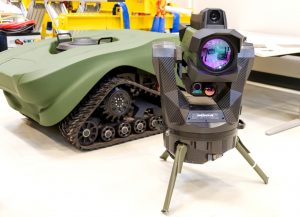
A controlling touch-screen tablet represents the man-machine interface, showing the aiming camera image on a display and allowing the operator steering and focusing the system head and shifting from one mode to another. The system seen at the MBDA Germany facility was installed on a tripod; a quick release system allows to remove the MILOS-D head from the tripod used for dismounted operations and quickly fit it on a vehicle, or viceversa. The final product should be capable to be transported by a team of three soldiers, carrying up to 25 kg each, however the model seen in Schrobenhausen laboratories is still overweight being a laboratory equipment. The current laser source alone has a mass of 25 kg, however MBDA Deutschland is already working with another provider that should deliver an 8 kg laser source with the same 3 kW output, SWAP being considered also for other components. EDR On-Line understood that the telescope seen on the MILOS-D technology demonstrator can be connected to a laser with an output up to 10 kW.
The company didn’t provided information on a timeline for the new demonstrator availability and testing.
Photos courtesy MBDA

